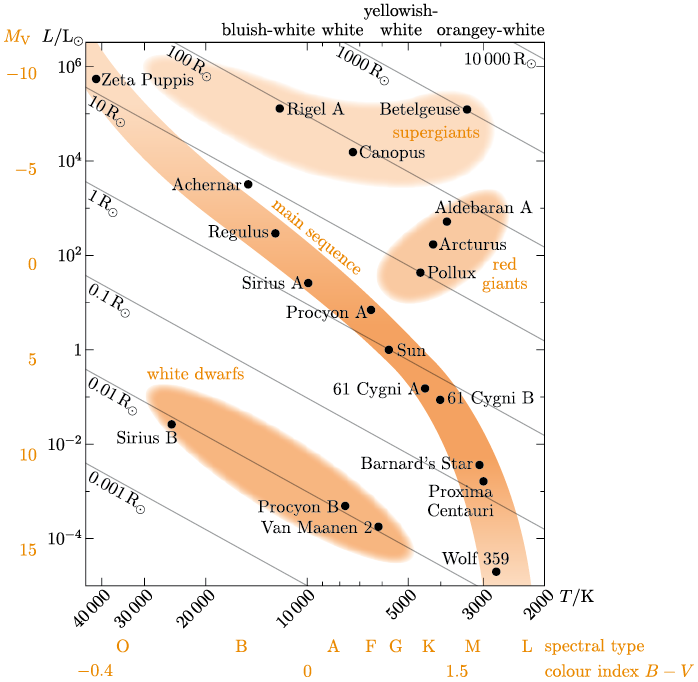1 The life cycle of stars
Stars form from clouds of gas that collapse under the influence of gravity until their central temperatures and pressures become high enough for nuclear fusion to be initiated in their cores. At this point, the clouds stop contracting further and are maintained in hydrostatic equilibrium with a balance between the inward force of gravity and the outward force due to their internal pressure. Stars are typically initially composed of about 75% hydrogen and 25% helium, with small traces of other elements.
Stars are observed with a wide range of masses, ranging from around one-tenth that of the Sun to over a hundred times the Sun’s mass. Other characteristics of stars include their radii, surface temperature and luminosity. Usually it is only stars’ surface temperatures (characterised by their colour) and luminosities (characterised by their brightness) that are directly observable. When these two quantities are plotted against each other for a population of stars, on a so-called Hertzsprung–Russell diagram (see Figure 1), certain patterns emerge in the stars’ locations.

Most stars are found in a band running from the top left to bottom right of the H–R diagram, known as the main sequence. This is where all stars spend most of their lives as they undergo nuclear fusion in their cores, converting hydrogen into helium, and releasing energy. On the main sequence, the hottest, most luminous stars sit at the top left; these stars are the most massive and the largest. The coolest, least luminous stars sit at the bottom right; these stars are the least massive and the smallest. The most massive stars have relatively short main-sequence lifetimes of only a few tens of millions of years, whilst the least massive ones have main-sequence lifetimes of hundreds of billions of years (longer than the current age of the Universe).
When most of the hydrogen in the core of a star is depleted, its outer layers will expand and the star will move towards the right of the main sequence, such that its surface appears cooler. This is the region known as the red giant branch. To begin with, hydrogen fusion occurs in a shell around the inert helium core, but as the central temperature and pressure rise further, helium fusion is initiated in the centre of the star. The star then moves back down to somewhat lower luminosities and hotter temperatures, at the lower end of the red giant branch. This new fusion process converts helium into carbon and oxygen in the star’s core, again releasing energy. Low mass stars (< 3 M☉) and intermediate mass stars (in the range 3–8 M☉) ultimately begin a second ascent of the red giant branch (known as the asymptotic giant branch, or AGB) when core helium is exhausted and helium fusion only continues in a shell surrounding an inert carbon/oxygen core.
Massive stars (> 8 M☉) leave the upper main sequence when their core hydrogen is exhausted and then track back and forth along the supergiant branch as new sources of fusion in turn become active and are then depleted. Unlike lower mass stars whose fusion ends with carbon and oxygen, they can initiate further fusion reactions, converting carbon and oxygen into elements such as neon, magnesium, silicon and ultimately iron. They will end up with an ‘onion-like’ structure with shells of less massive elements surrounding shells of heavier elements towards the core. Once the core is composed of iron, no further fusion reactions are possible as reactions to produce nuclei heavier than iron require more energy to be put in than is released.
The subsequent evolution of stars once all nuclear reactions cease is the main topic of this course, which will be explored in the following sections.
